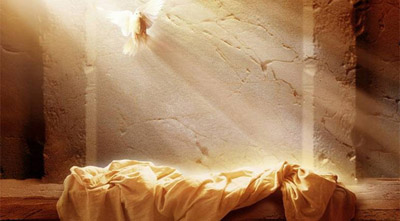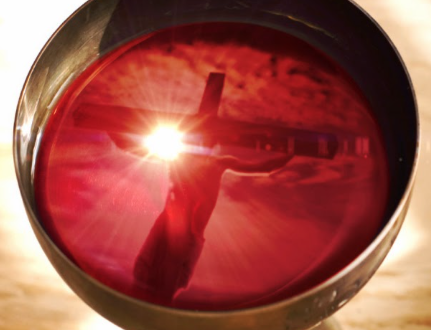
Believing and Living
The Revised Common Lectionary for Sunday, March 29th, spotlights Jesus’ restoration of Lazarus to life. This amazing account, as recorded in John 11, offers believers timely hope amid an ongoing global pandemic.
As Jesus’ prospect of suffering and death grew closer, He returned to the area of Jerusalem. Though the religious establishment spurned Him (10:39), His closest followers loved Him. Even rejection and scorn could not dim the glory of the Messiah as displayed through the restoration of Lazarus to life, a miracle that likely occurred in the winter of AD 29.
The record of the above incident is important, for it serves as an undisputed, confirming sign of the eternal, incarnate Word’s divine authority. The episode also set in motion the plot of Jesus’ enemies to finally eliminate Him.
According to 11:1, Lazarus lived in Bethany with his sisters, Mary and Martha. The village was located on the east side of the Mount of Olives, along the road leading toward Jericho. Bethany was also about two miles from Jerusalem (v. 18)—close enough for Jesus and His disciples to be in danger, but sufficiently far away to avoid attracting unwelcome attention.
John 12:2 says that a week before Jesus’ crucifixion, a feast was held in His honor at Bethany. Matthew 26:6 reveals that it was at the home of Simon the Leper, someone else whom Jesus knew in the city. Luke 24:50–51 also records that Jesus’ ascension took place near Bethany.
The first mention in the Fourth Gospel of the family of Lazarus, Mary, and Martha is found in 11:1. The sisters are also mentioned in Luke 10:38–42, and Mary’s anointing of Jesus is recorded in John 12:1–8. In fact, in anticipation of the preceding event, 11:2 says that Mary was the woman who poured the expensive perfume on the Messiah’s feet and wiped them with her hair.
Somehow Lazarus became ill, and his condition worsened to the point that Mary and Martha turned to Jesus for help (v. 3). The sisters undoubtedly had seen Jesus perform many miracles. They were convinced of His ability to help Lazarus.
The message to the Savior most likely took about a day to reach Him (somewhere across the Jordan River; 10:40). He, in turn, remained where He was at two more days (11:6), and it probably took about a day for Jesus and His disciples to reach Bethany.
It may be that Lazarus died before the messenger reached Jesus. If so, this explains how Lazarus could have been in the grave for four days (v. 17).
Jesus’ disciples also heard the grim news about Lazarus. They knew how much Mary, Martha, and Lazarus meant to Jesus. The Messiah’s friendship with Mary and Martha is well documented in the Gospels and was apparently familiar to the Fourth Gospel’s first-century readers.
John 11:5 emphasizes that Jesus loved each member of the family. Jesus’ friendship with Mary, Martha, and Lazarus showcases the humanity of the Lord. Although He was the divine Word, whom the Father sent to die for humanity’s sins, Jesus still experienced the same needs as people do today.
So, it should not be surprising that Jesus had close friends who were dear to Him. In fact, it is reasonable to expect that He would want such relationships outside His ministry and work.
Mary seemed to have a more emotional and devoted relationship with Jesus, as is shown when she fell down at the Messiah’s feet after coming to Him (v. 32). Perhaps the most dramatic example of Mary’s devotion to Jesus is found in the record of the dinner party that Martha and Mary prepared for the Savior prior to His final entry into Jerusalem (12:1–8). The encounter was sufficiently well known in the church for John to refer to it before he wrote about it (11:2).
Most likely, Jesus sensed His disciples’ concern for Lazarus and for this reason gave them an explanation that both reassured and puzzled them. First, the Messiah sought to allay the fears of the Twelve by noting that the illness would not “result in death” (v. 4). Jesus did not mean that Lazarus would not physically die, but that the end of his condition would be life, not death.
Second, Jesus explained that both He and the Father would be glorified in the situation. Third, Jesus did not rush off to Bethany in a panic. Instead, He stayed where He was for two more days (v. 6).
One reason for the above delay is that the Son operated according to the Father’s timetable, not that of people. A second reason is that the delay would ensure Lazarus had been dead long enough to prevent others from either misinterpreting the miracle as a fraud or as merely a resuscitation.
Jesus must have surprised His disciples by announcing that He was setting out for Bethany, which was in the province of Judea (v. 7). The choice was theirs as to whether they would accompany the itinerant rabbi from Nazareth despite the peril that awaited.
When the Twelve voiced concern for Jesus’ safety, He responded with an adage probably common at the time, but that had added meaning coming from Him (v. 8). During the winter season, there were typically 12 hours of daylight.
With the preceding truism in mind, the Redeemer spoke about walking in the light and in the darkness. On the one hand, people who walk in the light do not stumble, because they are able to see. Yet, on the other hand, people who walk in the darkness stumble because they are unable to see.
The above is not only true regarding physical conditions, but also valid concerning a person’s spiritual journey. As long as the Son operated in the Father’s will, no harm would come to Jesus. Similarly, only those who walk with the Messiah, the light of the world, can see and avoid stumbling spiritually (vv. 9–10).
Next, Jesus explained that Lazarus had “fallen asleep” (v. 11), which was a euphemistic reference to death (Gen 47:30; Matt 27:52; Mark 5:39; Acts 7:60; 1 Cor 15:51; 1 Thess 4:13). Jesus also stated that He was going to Bethany so that He could wake up Lazarus.
The disciples took Jesus to mean that Lazarus was literally sleeping, and so they were confused (John 11:13). In their minds, if Lazarus were sleeping, that meant he would also get better on his own (v. 12).
Realizing His disciples’ confusion, Jesus stated plainly that Lazarus had died (v. 14). The Son of God demonstrated His supernatural power to know the state of things beyond normal human ability.
Next, Jesus explained that the current circumstance would give His followers another opportunity to believe in Him (v. 15). After all, if Jesus had been with Lazarus during the final moments of his life and healed him of his sickness, the opportunity for an even greater miracle would have been lost.
Jesus intended to use the death of Lazarus as an occasion to demonstrate to the disciples (and other eyewitnesses) the Creator’s power over death. This was not a trivial desire on the part of the Savior. He knew that His closest followers needed their faith in Him clarified, matured, and strengthened.
Consider, for example, the dialogue between Martha and Jesus, which is recorded in verses 17–27. Despite Jesus’ statement that Lazarus would rise again, Martha failed to grasp what Jesus was saying.
Instead, Martha affirmed a more general theological truth about the resurrection of the righteous. Even when Jesus plainly declared Himself to be the “resurrection and the life” (v. 25), Martha still failed to understand what this meant for Lazarus.
Though Martha affirmed Jesus’ messiahship (vv. 26–27), Martha remained unaware of the fact that Jesus would restore Lazarus to life. Furthermore, Martha’s sister, Mary, and their friends remained just as oblivious to the truth of what Jesus said He would do for Lazarus (vv. 28–37).
Verse 16 records the statement made by Thomas, who was also called Didymus. Both names mean the “twin” (Matt. 10:3; Mark 3:18; Luke 6:15; Acts 1:13).
It remains unknown who this disciple’s twin sibling might have been (whether a brother or sister). Thomas was also known as the doubter because he initially refused to accept the testimony of the other disciples concerning the risen Lord (John 20:24–29).
In the episode involving Lazarus, Thomas challenged his peers to go with Jesus back to Judea, where death seemed imminent for all of them (v. 16). This is the first time John mentioned Thomas. His comment shows his leadership and courage, even though he struggled with personal doubts.
After Jesus and His group arrived in Bethany, they learned that four days earlier the body of Lazarus had been placed in a tomb (v. 17). Since a dead body decayed quickly in the hot Palestinian climate, the family of Lazarus would have had his body anointed, wrapped, and laid in the family tomb soon after he had expired.
The passage of four days is significant in that Jesus would not have reached His friend while he was still alive, even if the Savior had immediately left the Jordan Valley after hearing about the illness of Lazarus. The delay was to assure, in the minds of bystanders, that the restoration of Lazarus to life was truly a miracle.
Since Jerusalem was no more than a few miles from Bethany (vs. 18), a number of Jews from the city paid their respects to Martha and Mary during their time of grief (v. 19). Evidently, this family had a commanding influence or was popular among the local residents. The proximity between Bethany and Jerusalem indicates that news of the miracle would have circulated quickly throughout the holy city.
When the sisters of Lazarus heard that Jesus was approaching their village, Martha went out to greet Him, while Mary remained in the house (vs. 20). On the surface, Martha’s first words to Jesus seem to be a veiled rebuke (v. 21). After all, she previously scolded Jesus for her sister’s apparent idleness.
Martha, however, probably knew that Jesus could not come in time to heal her brother of his illness. So, Martha’s comment was more likely an expression of regret that Jesus could not be present, a feeling the sisters probably spoke about quite often during the previous four days.
Martha’s next remark might be interpreted as a sign of remarkable faith in Jesus’ power to raise people from the dead (v. 22). Yet, later, Martha was the one who complained when Jesus ordered the stone to be removed from the entrance to the tomb of Lazarus (v. 39). It is possible that Martha was merely noting that she still had faith in Jesus, for Martha was certain that God granted Jesus whatever request He asked (v. 22).
The Savior declared to Martha that her brother would rise from the dead (v. 23). In turn, Martha showed that she had not thought about Jesus’ bringing Lazarus back to life at that time. Instead, Martha voiced the view held by the Pharisees that God would resurrect the just on the last day (v. 24; see Isa 26:19; Dan 12:2; Matt 22:23; Acts 23:7–8).
Perhaps others had verbalized various forms of the preceding statement to Martha and her sister to comfort them. If so, hearing it once more might have sounded hollow to Martha.
Jesus’ response to Martha is incredible. He could have said that He would resurrect Lazarus. Instead, Jesus asserted, “I am the resurrection and the life” (John 11:25).
Jesus’ declaration is the fifth of seven “I am” statements in the Fourth Gospel that highlight His divinity and messiahship. Jesus, in fact, is the life of the age to come, and all who put their trust in Him will experience the resurrected life (v. 26).
When Jesus asked Martha whether she believed what He was saying, He was actually asking her whether she believed in Him. The Messiah wanted her (and all other people) to begin right now experiencing the joys of eternal life.
The restoration of Lazarus to life was intended to foster such faith in the Son of God. Also, the Evangelist’s inclusion of this miracle in the Fourth Gospel was designed to encourage people down through the ages to put their trust in Jesus as the Messiah (20:30–31).
Regardless of Martha’s fretful nature, she had amazing faith in Jesus. Martha not only replied positively, but also was clear about what she believed—that Jesus is the Messiah, God’s only divine Son. Furthermore, Martha affirmed that Jesus left heaven and entered the world by becoming a human being (11:27).
Few, if any, could have affirmed the Son any better than Martha. Her confession of faith parallels that voiced earlier by Peter (Matt 16:16).
Then Martha left Jesus outside the village and went back home and told Mary that the Rabbi wanted to see her (John 11:28). Naturally, Mary took Jesus’ request as a command and hurried to the place where Martha had conversed with Him.
Apparently, Mary was in such a rush to comply—and probably was also anxious to see Jesus—that her Jewish comforters (for example, relatives, friends, and neighbors) took notice and followed her. They assumed that Mary was going to continue her mourning at her brother’s tomb and thought they would join in her grieving (vv. 29–31).
Although Mary’s words are almost identical to her sister’s first statements to Jesus, Mary’s actions departed dramatically from Martha’s. Mary fell in homage at the feet of the Lord Jesus and wept as she spoke (v. 32). Mary, too, believed Jesus had the power to heal her brother of his illness, but now it appeared to be too late.
The Messiah eventually arrived at the tomb where the body of Lazarus had been placed. Verse 33 says that at the sight of the wailing, Jesus was “deeply moved in his spirit and troubled.”
On one level, the above phrase suggests Jesus was filled with empathy at the sight and perhaps indignant at the sorrow caused by death that sin has brought to the human condition. On another level, though, the Savior seemed agitated by the unbelief of His closest followers.
After all, the Messiah had plainly stated that He would restore Lazarus to life. Nonetheless, Martha and Mary, instead of rejoicing over what the Son was about to do, remained filled with despair over their brother’s death. This attitude of unbelief and doubt is reflected in the statement made by some of the onlookers (recorded in v. 37).
So that Jesus could demonstrate His divine power at Lazarus’s tomb, Jesus asked where the burial site was located (v. 34). As the sisters directed Jesus to the grave, He showed His grief by crying (v. 35). The Greek verb used to describe His tears suggests a quiet shedding of tears, not the pretentious, loud wailing of the other mourners.
In response to Jesus’ display of emotion, some of bystanders noted how much He loved His friend (v. 36), while others wondered why He had not healed Lazarus of his sickness. After all, Jesus was able to restore sight to a blind man several months earlier (v. 37; see 9:1–7).
None of the onlookers, however, were anticipating the awesome display of glory that was about to occur in their presence. God’s glory often shines brightest when circumstances seem like they could not be darker.
One can only imagine the emotions the Son felt as He approached the tomb of Lazarus, a cave with a stone rolled across its entrance (11:38). In Jesus’ day, people used caves carved in the limestone rock of a hillside as tombs. These graves were large enough for people to walk inside, and a tomb could hold several corpses.
Martha did not understand why Jesus would want the stone removed from the tomb’s entrance. Martha noted that after four days, the smell from the decomposing corpse of Lazarus would be terrible (v. 39).
The Messiah, ever patient amid such confusion, stated once again that if Martha had faith, she would witness the glory of God (for example, in Jesus’ restoring Lazarus to life; v. 40).
Unlike the Egyptians, the Jews in Jesus’ day neither tightly wrapped the body of the deceased nor embalmed it. Instead, they loosely wrapped the body in linen cloth and added spices between the layers and folds. The aromatic spices helped to counteract (but not completely eliminate) the objectionable odors resulting from the decomposition of the corpse.
One can only imagine the bewilderment and skepticism among the onlookers. Though Jesus’ command to remove the stone from the tomb of Lazarus seemed to go against common sense, it was done anyway (v. 41).
The prayer voiced by the Son, which is recorded in verses 41 and 42, is not so much a petition as it is an expression of thanksgiving to the Father. The Anointed One knew in advance that the Father would grant His request, and so the Redeemer gave thanks for this.
Jesus declared in the hearing of the eyewitnesses that the Father always answered His requests. Jesus stated this openly, not for His own benefit, but rather for the sake of the bystanders. It was His desire that in seeing the miracle, they would believe His claim to be the Messiah.
In restoring Lazarus to life, Jesus would prove that He is the master of death. Ironically, though, this miracle set in motion a series of events that would lead directly to His arrest and eventual execution. Yet, even in the Son’s crucifixion, both He and the Father would be glorified (17:1, 5).
When Jesus had finished praying, He simply and directly commanded Lazarus to exit from the tomb (11:43). In one sense, this served as a preview of the power of the Son that would be fully displayed in the final resurrection when all who had died, heard Jesus’ voice and lived (5:25, 28-29).
Lazarus, who had been unquestionably dead, came out of the tomb. His hands and feet were still wrapped with strips of burial cloth, and a separate cloth covered his face. Next, Jesus told the people to unwrap the burial clothes and headcloth from Lazarus and let him go (11:44). By doing this, they would know that Lazarus was truly alive and that his appearance was not merely a magic trick.
Key ideas to contemplate
Jesus had raised others from the dead, such as Jairus’ daughter (Matt 9:18–26; Mark 5:21–43; Luke 8:40–56) and a widow’s son (Luke 7:11–17). Yet, as described by the Evangelist in the Fourth Gospel, Jesus’ restoration of Lazarus to life was the Messiah’s crowning miracle (aside from His own resurrection), and it led the religious leaders to begin plotting Jesus’ death.
A short time after restoring Lazarus, to the glory of God, Jesus would raise Himself from the dead, as well to the glory of God. So, Jesus not only has power over life and death, but also He is the giver of life, once more to the glory of God.
1. WHAT DRIVES GOD’S TIMING? When Jesus received news of Lazarus’s illness, Jesus waited two days before beginning His journey to Bethany. Yet, His delay had a specific purpose. God, too, may seem—in our opinion—slow or neglectful to answer our prayers. Yet, the Creator is never late. Though He may seem to delay, He meets our needs according to His own perfect sense of timing.
2. WHAT BRINGS GOD GLORY? To Martha and Mary, waiting anxiously for Jesus’ arrival was a trial to endure, and their brother’s death caused them to question Jesus’ motives for delaying His return. Yet, when Christians face a trial, they have the great potential of bringing glory to God, especially when they keep trusting Him in the midst of the anguish. The Creator has the ability to bring Himself eternal glory from disastrous situations.
3. WHAT PROMPTS GOD TO GRIEVE? Jesus was greatly disturbed when He came to the tomb of Lazarus—even to the point of quietly weeping. The selfish criticism others lodged against Jesus for not making it back to Bethany in time to save Lazarus, along with the foolish disbelief and disregard for who He was, both upset and bothered Him. Didn’t the people have enough faith to realize Jesus’ power over life and death? Disbelief and disregard for Jesus still grieves the Spirit of God today.
4. WHAT BRINGS ABOUT GOD’S RESPONSE? Jesus told Martha that those who trusted in the Messiah would live eternally with Him in heaven (John 11:25–26). Jesus later reminded Mary that by believing Him, Mary would see God’s glory (v. 40). From this we recognize that believing in Jesus is inseparably linked to the Creator’s response. Indeed, He will do glorious things in response to belief.



